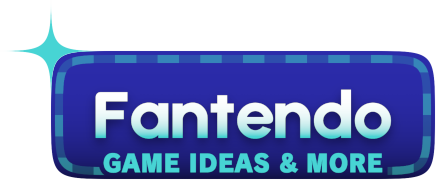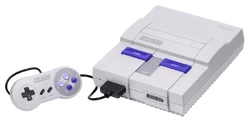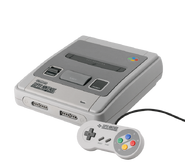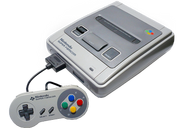| Super Nintendo Entertainment System is not from Fantendo. However, this article may include related fan ideas.
These external sources may have official, more accurate information: This article is free to edit. Please follow the article standards and respect good-faith contributions. |
| |||
| Developer(s) | Nintendo | ||
| Manufacturer(s) | Nintendo | ||
| Console Type | Console | ||
| Generation | Fourth | ||
| Online Connectivity | Satellaview (Only on Japan) | ||
| Release Date(s) | |||
| November 21, 1990 (Japan) November 25, 1990 (South Korea) August 23, 1991 (United States, Canada, Mexico and Latin America) April 11, 1992 (United Kingdom and Ireland) June 1992 (European Continent) July 3, 1992 (Australia) September 1992 (Brazil) | |||
| Discontinued | 1999 (United States, Canada, Mexico and Latin America) April 1, 2003 (South Korea) September 25, 2003 (Japan) 2003 (Brazil) | ||
| Best selling game | Super Mario World | ||
| Media | ROM cartridge | ||
| CPU | Ricoh 5A22 @ 3.58 MHz | ||
| Feature(s) | |||
| 16-bit graphics | |||
| Backward Compatibility | Game Boy (Super Game Boy) | ||
| Predecessor | Nintendo Entertainment System | ||
| Successor | Nintendo 64 | ||
The Super Nintendo Entertainment System (also known as the Super NES, SNES or Super Nintendo) is a video game console that was released by Nintendo in North America, Europe, Australasia, Oceania, and South America between 1990 and 1993. In Japan and Southeast Asia, the system is called the Super Famicom (スーパーファミコン?, officially adopting the abbreviated name of its predecessor, the Family Computer), or SFC for short. In South Korea, it is known as the Super Comboy (슈퍼 컴보이) and was distributed by Hyundai Electronics. Although each version is essentially the same, several forms of regional lockout prevent the different versions from being compatible with one another.
The Super Nintendo Entertainment System was Nintendo's second home console, following the Nintendo Entertainment System (NES). The console introduced advanced graphics and sound capabilities compared with other consoles at the time. Additionally, development of a variety of enhancement chips (which were integrated on game circuit boards) helped to keep it competitive in the marketplace.
The SNES was a global success, becoming the best-selling console of the 16-bit era despite its relatively late start and the fierce competition it faced in North America and Europe from Sega's Genesis console. The SNES remained popular well into the 32-bit era, and although Nintendo no longer offers factory repairs/replacement or accessories for the console, it continues to be popular among fans, collectors, retro gamers, and emulation enthusiasts, some of whom are still making homebrew ROM images. Its games would later be made available through the Wii, Nintendo 3DS, and Wii U Virtual Console, as well as the Nintendo Switch in the form of Super Nintendo Entertainment System - Nintendo Switch Online, available only to members of the system's online service.
Redesigns[]
The console initial build of the console was split into three versions depending on the region. The Super Famicom was a successor to the Famicom, the Japanese equivalent of the NES. Likewise, the SNES was later released, being a successor to the NES. Later, in Europe, a third version was made, which was smaller, more compact, and combined design elements of the SNES and Super Famicom. Later, a revision design was made for both the North American and Japanese consoles.
New-Style Super NES[]

The New-Style Super NES.

The Super Famicom Jr.
Released in 1997, the New-Style Super NES, also known by its model number SNS-101, was a compact redesign of the original model, similar to the New-Style NES from the previous generation. In Japan, an equivalent known as the Super Famicom Jr. also released. It was marketed as a low-price, entry-level gamer's system for customers who were on a budget and may have been put off by the higher-priced modern consoles, such as the Nintendo 64 and PlayStation. To meet this price point, some features were cut from the original, such as the removal of the expansion slot below the cartridge slot, making it incompatible with the Satellaview, the eject button, the LED light indicating when the console is turned on, and the internal RF modulator (although an external one can still be used).
The controller also got a slight redesign. The "Super Nintendo Entertainment System" logo along the top was changed to a broader "Nintendo" logo, and the back bears the stickers of both the SNES and Super Famicom consoles. Like the original model, the same controller was used for both models, but with recolored buttons to match the respective region's branding.
Accessories[]
Controller[]

The Super Famicom Controller.
The controller features A, B, X, and Y buttons arranged in a diamond pattern and two L and R shoulder buttons, along with a directional pad, a start button, and a select button. This controller is notable for popularizing the button layout that has become standard in consoles to this day. The design of the controller was slightly different between regions. In Japan and Europe, the controller had bright colors for each button, which matched the logo for the Super Famicom. Meanwhile, the North American console made the A and B buttons purple and the X and Y buttons lavender, matching with the design of the console itself. The shape was more rounded as opposed to the NES controller's brick-like design, making it more comfortable to hold.
Super Game Boy[]
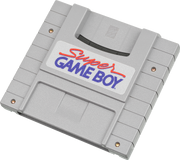
The Super Game Boy.
The Super Game Boy was a special cartridge for the SNES released in 1994. It could be inserted into the console like any game cartridge, but had a special slot that could accept Game Boy games, as well as Game Boy Color games as long as they were compatible with the original Game Boy. This allowed players to play these games on the TV. The Super Game Boy allowed various pallets to be used, letting players choose from a set of pre-selected pallets or being able to create their own. Because of the Game Boy screen and most TVs having different screen dimensions, some games such as Donkey Kong '94, the Game & Watch Gallery series, and Wario Land II, take advantage of it by having custom borders whenever they're played with the Super Game Boy. Some games, like Wario Blast: Featuring Bomberman!, even allowed for two-player co-op through the use of a second controller.
Super NES Mouse[]

The Super NES Mouse.
The Super NES Mouse was only compatible with the North American model, and mimiced the appearance of an actual computer mouse. It could be plugged into one of the system's controller ports and be used in place of one. Certain games were only compatible with this add-on, including Mario Paint (which the Super NES Mouse was often bundled with), Mario & Wario, and the Mario's Early Years series.
Super Multitap[]

The Super Multitap.
Released by Hudson Soft, the Super Multitap allows the SNES to support up to five players. It plugs into the console's second controller port, and itself has four controller ports that can be used. However, this only worked with specific games that support it.
Super Scope[]

The Super Scope.
The Super Scope was a successor to the NES Zapper for the NES, being a light gun that fires an infrared beam that is picked up by a sensor placed on top of the TV. Compared to the Zapper's handgun-esque design, the Super Scope resembles more like a sniper rifle. It was bundled with Super Scope 6, a compilation of six games that showcase the use of the peripheral, and it was compatible with other games like Yoshi's Safari. Notably, it appears as an item in the Super Smash Bros. series, being able to fire light-based projectiles at a quick pace.
Satellaview[]
- Main article: Satellaview
SF Memory Cassette[]

The SF Memory Casette.
The SF Memory Casette was only produced in Japan. It was apart of the Nintendo Power service which ran from 1997 to 2007, allowing players to download select SNES games onto a special flash memory cartridge, which could be rewritten. This was made to be a cheaper alternative to purchasing retail games after the success of the download service of the Family Computer Disk System.
Super NES Cleaning Kit[]

The Super NES Cleaning Kit.
Much like the NES, a Cleaning Kit for SNES cartridges was released. Over time, pins inside the SNES and its game cartridges would get dirty and start malfunctioning. As a result, Nintendo released a cleaning kit to improve the condition of the contacts so games could resume uninterrupted, as well as fix any visual glitches.
Super NES Classic Edition[]
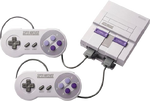
The Super NES Classic Edition.

The Nintendo Classic Mini: Super Famicom.
The Super NES Classic Edition was a smaller version of the SNES and a successor to the NES Classic Edition, announced on June 26, 2017 and released on September 29, 2017. Likewise, in Japan, the Nintendo Classic Mini: Super Famicom was released, being a miniature version of the Super Famicom. Like its predecessor, the system was much smaller than a standard model, and included 21 pre-installed, being some of the most popular games in the system's library, including Super Mario World, The Legend of Zelda: A Link to the Past, and Super Metroid. Unlike its predecessor, it came bundled with two controllers, which were almost identical to the original ones, but with a smaller connection cable. The system was also compatible with Wii controllers, allowing the player to use the Wii Classic Controller. Also, the console included Star Fox 2, a completed game that was cancelled due to licensing problems, making this the first time it was officially playable.
Like its predecessor, the Super NES Classic would be discontinued on December 2018.
Games[]
